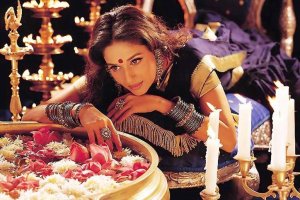Songs are an integral part of Hindi cinema. Over the years since the release of India’s first talkie film Alam Ara (1931), songs have played many roles in the films – sometimes they are used as just fillers; sometimes they are used as dialogues; sometimes they are used for entertainment; sometimes they act as a support in carrying the narrative ahead. Apart from the mentioned roles, songs in Hindi cinema have also been used to comment on the socio-economic conditions of our society or nation. Songs like “Jinhein naaz hai Hind par wo kahaan hain?”, “Ye duniya agar mil bhi jaaye to kya hai?” (both from Pyaasa (1957)), “Haal chaal theek thaak hai” from Mere Apne (1971), “Salaam kijiye aali janaab aaye hain” from Aandhi (1975), “Nafrat ki laathi todo” from Desh Premee (1982), “Ghapla Hai” from Hu Tu Tu (1999) etc. are some of the best examples. These songs resonate with each one of us on many levels. They talk on our behalf and make us feel heard.
Raj Kapoor’s films have always addressed the grieving issues of the society and sympathised with the downtrodden, the oppressed and the marginalised section. Films like Awaara (1951), Anari (1959), Jaagte Raho (1956), Shree 420 (1955) etc. have taken a subtle dig at the upper class’ hypocrisy and their pursuit for greed and materialistic pleasures. This is also the reason why these films were hits at the box office as they resonated well with the audience. Raj Kapoor was not a Communist by ideology but he had deep sympathy for the working class and lower class people. His close associate and screenwriter Khwaja Ahmed Abbas, although, was a member of Communist Party and also the general secretary of IPTA (Indian People’s Theatre Association; the cultural wing of the Communist Party of India). One can thus figure out the genesis of such socialist themes which ruled the cinema of Raj Kapoor.
Just like his films, his songs too addressed the grave issues often neglected by everyone. The man behind those thought-provoking gems was lyricist Shailendra, who was also a close associate of Raj Kapoor and collaborated with him on numerous films, penning down hit and memorable songs which are on our lips even to this day. Like K.A. Abbas, Shailendra too was a member of the left wing IPTA. Not many know that he also belonged to Bahujan community, probably because the lyricist himself hid this identity for long. Shailendra’s words described the anguish of the poor in simple words. His songs found place in everyone’s heart and still work like a lullaby. Many even consider him the greatest poet after Sant Ravidas.
This piece is an attempt by me to break down and analyse one of the powerful songs that Shailendra has penned down – “Dil ka haal sune dilwala” from Raj Kapoor’s 1955 classic Shree 420. It is sung by the legendary Manna Dey and was composed by musical duo Shankar-Jaikishen, another regular collaborators of Raj Kapoor. The song is a superhit and works like a balm on the aching heart which has dreams stored in some corner.
“Dil ka haal sune dilwala
Seedhi si baat na mirch masala
Keh ke rahega kehne wala
Dil ka haal sune dilwala…”
The opening lines of the song describe the nature of Raj who represents the lower strata of the society. He is innocent, meek and vulnerable. His heart has a lot to say but it can only convey to someone who understands his plight. Naturally, who could understand it better than a group of people living on the footpath beneath the high mansion of some rich seth. This setting clearly signifies the oppression by the rich on the poor. When people insist Raj to tell them his story, he begins singing these lines, telling his plight to the ones who undergo the same trial of life everyday. This song is more of a plea to those living the life of luxury. It’s almost like the stubbornness of these people (kehke rahega kehne wala) to tell about their struggles as it is to everyone without adding spice or filter to it. Also, notice the “tch-tch, tch-tch” sound added to fill in the pauses in between in the entire song. This sound is often made while sympathising with someone or something. In this case, the inclusion of this sound urges us to sympathise with the poor people living on the footpath and listen to what they’re saying.
“Chhote se ghar mein gareeb ka beta
Main bhi hoon maa ke naseeb ka beta
Ranj-o-gham bachpan ke saathi
Aandhiyon mein jali jeevan baati
Bhookh ne hai bade pyaar se paala…”
In the first stanza, Shailendra gives us an insight into the story of every human dealing with poverty. His sensibilities as a poet are visible from these lines. He uses Raj as a device to share his anguish with everyone. Naturally, a poor man’s only treasure is his mother. Here, Raj is proud of his precious possession – his mother whom he has given an extremely special status. But reality hits us in the very second line where we are told how happiness and luxury isn’t something that people like Raj can afford. For them, it’s like a far-fetched dream. Their lives are an assortment of tears and sorrows since the beginning. They are like their childhood friends. Further, we are told how these people have survived the storm of poverty and hopelessness and accepted it as their life. This is their way of life and we need to open our eyes and have a look at them. Hunger is like their mother that takes their care with affection. It’s something which is selfless, never leaves their side and is always there with them. It has taught them how to live.
“Haaye karoon kya surat hai aisi
Gaanth ke poore chor ke jaisi
Chalta phirta jaan ke ek din
Bin dekhe pehchaan ke ek din
Baandh ke le gaya policewala…”
Shailendra has touched every aspect of poverty or say, being a poor, in this song. He has addressed the common but serious issues faced by the poor people on a daily basis. In the second stanza, he describes how due to their faces that seem like that of a wealthy thief, they are often scared of being arrested by the police without proper interrogation. This is true. These people are really prone to such incidents and police and officials show no mercy towards them. They are often taken into custody on some false pretext and even a false case is made against them. Here, we should also notice how the lyricist has infused an idiom (gaanth ka poora) in the song which means rich or wealthy. It’s a curse for the people belonging to the marginalized section to even have a pretty face, it seems.
“Boodhe daroga ne chashme se dekha
Aage se dekha, peechhe se dekha
Upar se dekha, neeche se dekha
Bola ye kya kar baithe ghotaala
Haaye ye kya kar baithe ghotaala
Ye to hai thanedaar ka saala…”
But what happens next seems like a comic relief in this song. The man held by the police turns out to be some relative of the police officer. They realise their mistake and feel embarrassed at the situation. This situation is put in the song to tell us how, if you have contacts, you instantly start receiving special attention and care even if you’re a criminal. The sad reality of our society and the corrupt judicial system is exposed in these lines. Even the biggest of the criminals roam outside freely just because of their contacts within the system which helps them every now and then.
“Gham se abhi azaad nahin main
Khush hoon magar abaad nahin main
Manzil mere paas khadi hai
Paaon mein lekin bedi padi hai
Taang adaata hai daulatwala…”
This particular stanza is my personal favourite as it encapsulates the daily struggle of the working class and portrays class discrimination in simple words. Theirs is the life of sorrows and misery. They too have their dreams of making it big, but often those are crushed by the cruel feet of the aristocrats. They are morose yet happy yet not satisfied and want more in life. Their destination is near but they still can’t move ahead as their feet are shackled by the system which promotes class discrimination. How Shailendra has openly declared that it’s because of the interference of the bourgeoisie that the lower class has been deprived of their goals, ambitions and happiness.
“Sun lo magar ye kisi se na kehna
Tinke ka le ke sahara na behna
Bin mausam malhaar na gaana
Aadhi raat ko mat chillaana
Varna pakad lega policewala…”
In the last stanza, Shailendra mentions the lack of freedom that the poor experiences in his own poetic way. Unlike the upper class, these people never really get complete freedom to express themselves. They can’t even be themselves and have to abide by the rules and regulations made solely for them by the society that always favours the privileged and looks down upon the underprivileged and marginalised community. In the end, the message is clear. If you don’t follow these set of rules, you’ll be jailed and punished for your ‘crime’. The poet/lyricist has made a sharp comment on the hypocrisy of the society.
Shailendra was a Bahujan poet and also a member of the IPTA. I’m reiterating these facts again because one should understand that the sensibilities and empathy that he possessed for the oppressed section of the society made their way to films through the memorable songs that he has composed for us and surely they can also be linked to his upbringing. The legendary lyricist has left behind him soulful gems for us that we cherish every day and will continue to do so for many generations to come.
You can enjoy the song here:















Add Comment